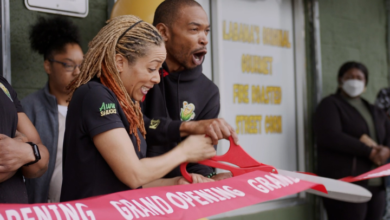Black man killed for trying to use whites-only bathroom in Alabama in 1966 set off protests that echo today – New York Daily News

Sammy Younge Jr. needed to pee.
But Younge was black, so fulfilling this routine bodily function could be complicated business 50 years ago in a place like Tuskegee, Ala., where the white minority clung like dying ivy to Jim Crow punctilios.
Marvin Segrest, a 67-year-old white man, stood between Younge and a toilet.
Segrest was night attendant at a gas station adjacent to the bus depot in Tuskegee. Younge, 21, was a freshman at Tuskegee Institute.
The student and the pump jockey crossed swords when Younge tried to use the station’s whites-only bathroom an hour before midnight on Jan. 3, 1966.
Segrest said Younge began “cussing and raising hell” when he turned him away.
So Segrest reached for his gun.
Tuskegee is the seat of Macon County, whose politics were an emblem of the success of black-voter suppression in the South. A white power structure dominated there into the mid-’60s, even though blacks outnumbered whites five to one.
Sammy Younge Jr. was working to change that.

He grew up in a middle-class household in Tuskegee. His father was an occupational therapist, his mother a teacher. His parents sent him to Cornwall Academy, a Massachusetts prep school, but he returned to Alabama to finish high school in Tuskegee, graduating in 1962.
He enlisted in the Navy, then enrolled at prestigious Tuskegee Institute following a medical discharge in 1964 after losing a kidney. Inspired by the Selma-to-Montgomery civil rights march in 1965, Younge helped lead a voter-registration campaign in Macon County, due west of Alabama’s capital city.
Younge became a protégé of James Forman, national leader of the Student Nonviolent Coordinating Committee. Forman later said Younge’s determination in registering black voters made him a target in Tuskegee.
The key witness to events at the gas station 50 years ago was a white bus driver who was idling his rig at the depot next door.
He heard two men arguing and watched as Younge took a golf club from a bus luggage rack. Marvin Segrest later said he mistook the club for a gun.
He leveled his .38 revolver on the young man from about 80 feet away and fired a shot. Segrest said he aimed at his feet “to bluff him.”
The bus driver said Younge turned and ran. He heard a second shot after Younge was out of sight.
An hour later, a friend of Segrest visited the police station to report that the attendant had “fired twice at somebody but didn’t think he hit them.”

Cops ambled over and found Younge lying dead, still clutching the golf club. He had been shot in the back of the head.
Harvey Sadler, the white Macon County sheriff, framed the case as a “dispute,” not “one of these civil rights cases.”
He added, “There is also a report that they were arguing over whether Younge could use the rest room in the filling station, but we haven’t been able to check this out.”
Asked by reporters whether Segrest had confessed, Sadler said he had been “too busy on the angles of the case” to speak to the presumed killer.
Segrest was arrested and indicted for second-degree murder only after Tuskegee students demonstrated on the town square, whose centerpiece is a Confederate memorial.
His attorney petitioned to move the trial to adjacent Lee County, which happened to be overwhelmingly white. Judge L.J. Tyner approved the change of venue, and an all-white male jury was impaneled for the trial in Opelika in December 1966.
The brief proceedings included three hours of testimony by Segrest, who raged with a frothy indignation.
Segrest said Younge told him, “The sooner you goddamn white folks know I don’t go to the back (bathroom), the better it will be for you.”

He peered at the jury and added, “I believe you gentlemen will believe me.”
The defense attorney called the shooting “an unfortunate accident” that hinged on the golf club as a potential weapon. But prosecutor Tom Young noted that 80 feet separated the men.
“I’ve never seen any kind of golf stick that has the range of a .38 pistol,” Young said.
Segrest’s white peers took just 70 minutes to acquit him.
Tuskegee students rampaged through downtown, breaking windows. They painted black the face of the Confederate soldier on the town square and added a yellow streak down his back.
The case proved to be a crossing of the Rubicon for local white power. The first black sheriff in modern Alabama took office in Macon County weeks after the Segrest trial, and elective offices were soon dominated by African-Americans.
Mab Segrest, a Tuskegee native, lesbian feminist writer and shirttail kin of Marvin Segrest, said echoes of the Younge slaying reverberate today.
“The current conflicts over bathroom access for transgender people replicate struggles over bathrooms segregated for white and black people during Jim Crow,” Segrest, author of “Memoir of a Race Traitor,” told the Justice Story. “Both assume a rigid binary system — black or white, male or female, no continuum or complexity.”
She added, “What we learn from Jim Crow bathroom rules was how power operates to control us at the most intimate levels … It was never about the rest rooms. It was about the power and control.”






















































